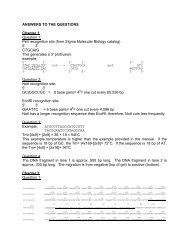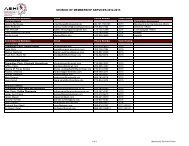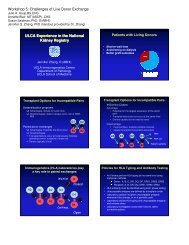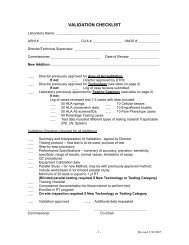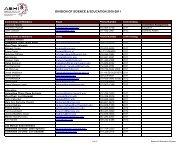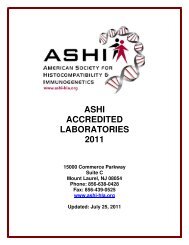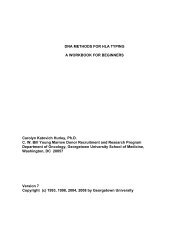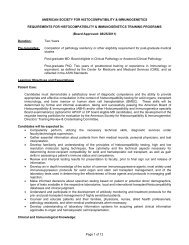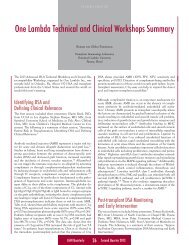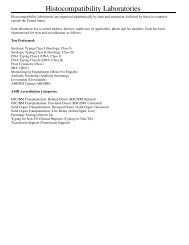CD138, HLA-DR, IgM, and IgD. The contribution of Fc receptors was assessed by CD23, CD32, andCD16. Cellular activation was analyzed by CD69. HLA expression level was quantified by monoclonalantibodies to monomorphic epitopes on either class I or II (G46-2.6 or Tü39).Results: On CD3+ cell subsets CD4+, CD4+/CD25+, CD8+CD56-, CD8+CD56+ HLA class I expressionlevel correlated linearly to MCS in serum with class I DSA. In serum with class II DSA, CD19+ cellsshowed a high degree of correlation between HLA-DR expression and MCS. For CD3+ cell subsets, theCD69+ activated <strong>for</strong>m of each subset had elevated HLA expression. While HLA class I and II expressionlevel varied on CD19+ cells, no one marker correlated with higher or lower HLA expression. However onCD19+ cells the level of Fc receptors (FcR) CD32 and CD23 correlated with bound IgG in sera withoutDSA. CD56+/CD16+ cells also showed a high degree of bound antibody in serum without DSA thatcorrelated with CD16 expression level.Conclusions: Different subsets of T and B cells have variable levels of HLA expression, which affect theMCS in and FCXM. This suggests that variation in relative proportions of these subsets could influenceFCXM results. Similarly, variation in FcR expression influences nonspecific antibody binding in a densitydependent manner.3-PPREDICTIVE VALUE OF USING LabScreen MIXED BEADS TO DETERMINE DILUTIONSNEEDED FOR QUANTITATIVE ANALYSIS ON LabScreen SINGLE ANTIGEN BEADS.P. Brailey, E. Portwood, A.L. Girnita. Transplantation Immunology Division, University of Cincinnati,Cincinnati, OH, USA.Aim: When analyzing solid organ transplant patients <strong>for</strong> HLA antibodies, the LabScreen Single AntigenBeads can be saturated with antibody. There are numerous consequences of bead saturation, with theinability to observe patient treatment response being one of the most significant. This inability requires theuse of dilution studies which are time and reagent intensive, and expensive. The aim of this study was todetermine if LabScreen Mixed Bead reagents could be used to determine the dilutions needed <strong>for</strong> SingleAntigen Bead analysis.Methods: LabScreen Mixed Beads (One Lambda, Inc.) were run against 4 renal patients at serial dilutionsfrom Neat to 1:1024 <strong>for</strong> both HLA Class I and Class II. The serum samples were first treated with DTT anddiluted using phosphate buffered saline (PBS). MFI values <strong>for</strong> either an immuno-dominant or donorspecific antibody were plotted on a graph. The graph was analyzed <strong>for</strong> the dilution values that were at thelower end of the linear portion of the graph. These values were used <strong>for</strong> dilutions of the LabScreen SingleAntigen Beads (One Lambda, Inc.) <strong>for</strong> that patient.Results: Mixed Bead dilution studies predicted that 3 of the 4 patients were diluted at 1:256 or 1:1024.LabScreen Single Antigen Bead studies at this dilution were successful <strong>for</strong> monitoring the patient’s therapyresponse. Mixed Bead dilution studies predicated <strong>for</strong> 1 patient successful dilution at 1:64, however thispatient actually required LabScreen Single Antigen Bead dilution at 1:2048.Conclusions: LabScreen Mixed Beads can be used to predict the dilutions needed <strong>for</strong> quantitative analysison LabScreen Single Antigen Beads <strong>for</strong> many patients. Care must be taken to observe that dilution studiesaccount <strong>for</strong> two linear curves on patients with extremely high levels of HLA antibodies.4-PUSE OF QUANTIPLEX BETWEEN INSTRUMENTS: WORTH THE BOTHER?Megan Brown, Anne Halpin, Luis Hidalgo, Patricia Campbell. Histocompatibility Laboratory, AlbertaHealth Services, Edmonton, AB, Canada.Aim: Many HLA laboratories use Luminex methodologies to identify HLA antibodies. QuantiplexBeads (One Lambda Inc) are reference beads <strong>for</strong> standardization of fluorescent signal. They are acquiredwith single antigen beads (LabScreen® products, One Lambda Inc) used to identify antibodies to HLAclass I (LSA1 beads). Quantiplex beads are intended to correct differences in instrument per<strong>for</strong>mance.Luminex output is measured as median fluorescence intensity (MFI); Quantiplex beads convert MFI tostandard fluorescence intensity (SFI) by creating a linear standard curve from Quantiplex bead values.We investigated whether Quantiplex beads provide standardization <strong>for</strong> the same samples run on twoLuminex instruments.
Methods: Sera (n=22) were tested <strong>for</strong> Class I antibodies using LSA1 beads (cat# LS1A04) as per themanufacturer’s product insert; the vacuum wash method was employed. The beads were acquired on twoLuminex instruments in 2 runs on 2 different days. Quantiplex beads (cat# LXQNTPLX) were acquiredwith each run. Raw data <strong>for</strong> all positive results (n=14) were exported to Microsoft Excel and analyzed.Spearman correlations were calculated using GraphPad Prism 5.Results: MFI and SFI have a correlation of 1.0 on the same instrument. The MFI to MFI and SFI to SFIcorrelations between instruments are 0.98. When the MFI vs SFI values are plotted on a line graph, thelines are almost identical, although the SFI values are higher. Slight differences in MFI and SFI output areobserved between instruments. One run shows slightly higher output on one instrument vs another and theopposite is seen in the second run. No observed instrument variation is corrected by SFI.Conclusions: Quantiplex TM beads are inexpensive but create additional work such as inventory, QC andadditional Fusion® import. Due to our inability to see a clear benefit with the use of Quantiplex beads,we conclude that they not worth the bother and we will discontinue their use.5-P“NATURAL” HLA ANTIBODIES IN THE PATIENTS ON UNOS KIDNEY OR PANCREASWAIT LIST.Heather A. Casey, Lorie H. Kumer, Carrie L. Mowery, Lori A. Malec, Margaret A. Maybach, Jennifer L.Tyler, Dorothy K. Felt, Jean A. Hess, Justine L. Gaspari, Ronald E. Domen, Hiroko Shike. HLALaboratory, Penn State Hershey Medical Center, Hershey, PA, USA.Aim: “Natural” HLA antibodies in nonalloimmunized healthy males was published by Morales-Buenrostro, et al (2<strong>00</strong>8), referring to naturally occurring non-HLA IgG antibody cross-reactive possibly tostructurally altered HLA antigens on the Luminex beads. The reactivity is considered clinicallyinsignificant and should not be assigned as HLA antibody specificity to patients. Recognition criteria areneeded.Methods: One Lambda LABScreen PRA Class I and II and LABScreen Single Antigen (SAB) were testedby Luminex <strong>for</strong> patients on wait lists in last 3 years. Specificity assigned by SAB (MFI ≥1<strong>00</strong>0 MFI) wastested by flow crossmatch (XM) of selected serum against donors with only one corresponding HLAantigen.Results: SAB, PRA, and XM results of 52 samples (n=38 <strong>for</strong> class I; n=14 <strong>for</strong> class II) were correlated togenerate criteria that may identify non-HLA SAB reactivity. The specificity was supported by clustering(pattern observation on HLA Fusion software) of PRA beads in 39 samples. Of the 39 samples, XM waspositive in 20/22 samples with corresponding PRA beads ≥1<strong>00</strong>0 MFI, and 10/17 samples withcorresponding PRA beads
- Page 1 and 2: Monday, September 27, 20102:00 PM -
- Page 3 and 4: 5-ORTWO CASES OF DONOR SPECIFIC ANT
- Page 5 and 6: Monday, September 27, 20102:00 PM -
- Page 7 and 8: Results: PHA-induced mRNA expressio
- Page 9 and 10: conjugated IgM (BD Biosciences), Ig
- Page 11 and 12: Methods: Peripheral blood and endom
- Page 13: Aim: NK cells have an established r
- Page 17 and 18: expression on lymphocytes, we hypot
- Page 19 and 20: Conclusions: Clean SA beads can eli
- Page 21 and 22: goal is to re-examine our previous
- Page 23 and 24: Aim: There is increasing evidence t
- Page 25 and 26: esult in poor graft survival. The g
- Page 27 and 28: Aim: Pronase treatment eliminates i
- Page 29 and 30: 34-PCLINICAL AND PATHOLOGICAL SIGNI
- Page 31 and 32: Nabil Mohsin, Isabelle G. Wood, Ind
- Page 33 and 34: donor/recipient pairs for transplan
- Page 35 and 36: and tested in the DynaChip assay fo
- Page 37 and 38: average difference between Ave and
- Page 39 and 40: Conclusions: The XM-One assay can b
- Page 41 and 42: 59-PCYTOTOXIC AND NON-CYTOTOXIC ANT
- Page 43 and 44: data suggests that DTT pretreatment
- Page 45 and 46: Bhavna Lavingia 1 , Chantale Lacell
- Page 47 and 48: ATG INTERFERNCE IN SINGLE ANTIGEN L
- Page 49 and 50: 75-PPREFORMED LOW REACTIVE ANTI-HLA
- Page 51 and 52: Sabarinathan Ramachandran 1 , Naohi
- Page 53 and 54: 83-PALLELIC DIVERSITY OF KIR2DL4 AN
- Page 55 and 56: São Paulo, Brazil; 3 Commissariat
- Page 57 and 58: 91-PCHARACTERIZATION OF COMMON AND
- Page 59 and 60: Conclusions: The extensive diversit
- Page 61 and 62: 99-PPOTENTIAL COMMON NOVEL ALLELES
- Page 63 and 64: 103-PTOWARDS A FUNCTIONAL HLA-DPB1
- Page 65 and 66:
107-PWHOLE GENOME AMPLIFICATION (WG
- Page 67 and 68:
111-PLOSS OF MISMATCHED HLA IN FAMI
- Page 69 and 70:
115-PDONOR EPITHELIAL CELL CHIMERIS
- Page 71 and 72:
Caucasian patients. MRs vary signif
- Page 73 and 74:
Results: We obtained the total No.
- Page 75 and 76:
cord blood and platelet transfusion
- Page 77 and 78:
131-PASSOCIATION OF IL-2-330(G/T) W
- Page 79 and 80:
Institute, Children’s Hospital Oa
- Page 81 and 82:
Methods: To prove the robustness of
- Page 83 and 84:
populations.We studied the involvem
- Page 85 and 86:
amplicons generated from different
- Page 87 and 88:
Results: The sequence of the unexpe
- Page 89 and 90:
concentration of the Taq Polymerase
- Page 91 and 92:
160-PASSOCIATION OF HAPLOTYPES WITH
- Page 93 and 94:
164-PDETECTION OF A DE NOVO DONOR S
- Page 95 and 96:
168-PA NOVEL HLA-DQB1 ALLELE CONFIR
- Page 97 and 98:
172-PSCREENING FOR HLA-SPECIFIC ALL
- Page 99 and 100:
176-PIMPLEMENTATION OF THE WORLD HE
- Page 101 and 102:
epertoire of displayed ligands and
- Page 103 and 104:
mucosa. No other samples were avail
- Page 105 and 106:
Conclusions: In previously reported
- Page 107 and 108:
Conclusions: Our findings can demon
- Page 109 and 110:
Conclusions: In analyzing this data
- Page 111 and 112:
examined on microarrays from a huma
- Page 113 and 114:
Methods: Serial analysis of sera ob
- Page 115 and 116:
Conclusions: These new technologies
- Page 117 and 118:
allograft injury. Four of these 18
- Page 119 and 120:
A NOVEL HLA CLASS I SINGLE ANTIGEN
- Page 121 and 122:
Results: Approximately twice as man
- Page 123:
Methods: Molecular HLA typing was p



